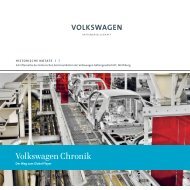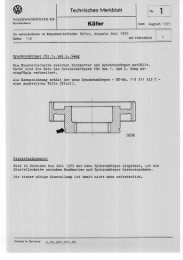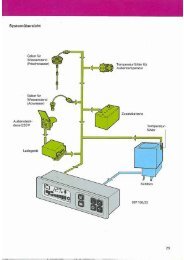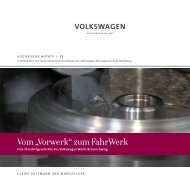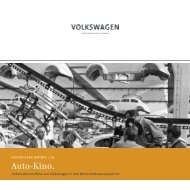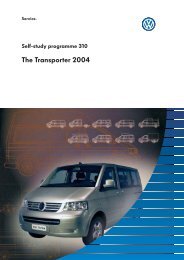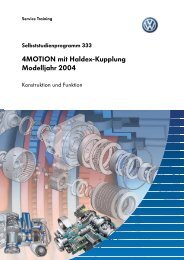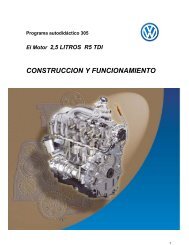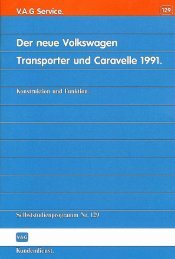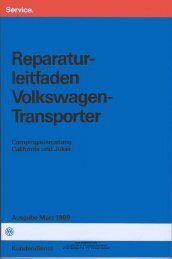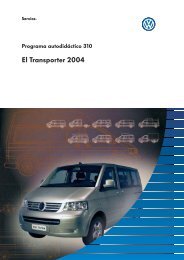HN 2: The British and their Works
HN 2: The British and their Works
HN 2: The British and their Works
Create successful ePaper yourself
Turn your PDF publications into a flip-book with our unique Google optimized e-Paper software.
In any case, it was a stroke of luck that the trusteeship had fallen<br />
to the <strong>British</strong>. Although the declaration passed by the victorious<br />
Allies on 2nd August 1945, at the end of the Potsdam Conference,<br />
stipulated that Germany’s arms industry should be crushed <strong>and</strong><br />
its industrial capacities restricted by dismantling factories, the<br />
relevant authorities at the Foreign Office in London were convinced<br />
that there was a close connection between the recovery<br />
of Engl<strong>and</strong>’s economy <strong>and</strong> the revival of Germany’s. <strong>The</strong> <strong>British</strong><br />
opposed the punitive approach of the American occupation<br />
directive JCS 1,067, which prohibited the military government<br />
from undertaking any measures for economic reconstruction<br />
beyond the guarantee of a moderate st<strong>and</strong>ard of living. On<br />
the contrary, they were prepared to avoid jeopardising the reconstruction<br />
of Western Europe by offering considerable<br />
support to those industrial sectors that were important for<br />
the peacetime economy. 11 Evidence of this is provided by the<br />
directive, adopted by the Economic <strong>and</strong> Industrial Planning Staff<br />
in July 1945, but not issued on account of the forthcoming<br />
Potsdam Agreement, concerning the treatment to be accorded<br />
to German industry. This instruction was not dictated in the<br />
spirit of the Morgenthau Plan, quite the contrary. It left to the<br />
Military Government the decision as to which economic measures<br />
should be regarded as essential, thus opening up a wide<br />
room for manoeuvre. In practice this took the form of a<br />
"constructive pragmatism" on the part of the occupying power. 12<br />
And what could be more obvious than to meet the enormous<br />
transportation requirements of the occupying power from a<br />
functioning Volkswagen production plant, especially when this<br />
opportunity was legalised by a clause in the Potsdam<br />
Agreement? <strong>The</strong> course of the war had led the Allies from<br />
Norm<strong>and</strong>y to Germany, resulting in extensive wear to <strong>their</strong><br />
military vehicles. Replacements were not forthcoming. <strong>The</strong> new<br />
two-seater all-terrain vehicle could not be produced before 1947;<br />
the model used during the war was liable to breakdowns, <strong>and</strong> in<br />
any case the manufacturer now preferred to build more<br />
profitable vehicles. For a while the confiscation of German<br />
civilian vehicles provided some relief, without being anything<br />
like sufficient to meet the growing transportation requirements.<br />
One way out of the transportation crisis could be a swift<br />
re-start of Volkswagen production. 13<br />
One of the most enthusiastic advocates of this solution was<br />
Colonel Michael McEvoy, whose responsibility for the REME<br />
workshops in the <strong>British</strong> zone made him aware of the urgent<br />
need for extra transportation capacities. Furthermore, the qualified<br />
automotive engineer had seen the Volkswagen at the<br />
International Motor Show in Berlin in early 1939 <strong>and</strong> had fond<br />
memories of it. It is thought that McEvoy approached the REME<br />
officers at the Volkswagen plant at the end of July 1945,<br />
instructing them to discuss a possible project with the factory<br />
management concerning the production of 20,000 Volkswagens<br />
for the <strong>British</strong> military government <strong>and</strong> German consumers.<br />
14 <strong>The</strong> plan was that production should be increased from<br />
an initial 500 vehicles in September 1945 to 2,000 in January<br />
1946, <strong>and</strong> should remain at this level until September of the<br />
same year. <strong>The</strong> REME had been instructed to submit a report by<br />
6th August 1945, setting out the requirements for materials <strong>and</strong><br />
labour, stipulating the urgently needed supplies <strong>and</strong> offering<br />
specific suggestions for completion of the project. This project<br />
was actively supported by Major Ivan Hirst, who was just as keen<br />
to produce the saloon as factory manager Rudolf Brörmann.<br />
Instead of stating his case in words, Hirst had an unused saloon<br />
found on the factory premises painted khaki at Colonel McEvoy’s



